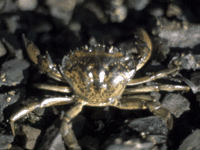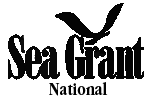

Long-term Research Goals
To answer these questions:
Users & Outreach: We will work with scientists, managers, and educators to develop a feasible efficient monitoring program based on our research, and integrate different social elements that can provide volunteer man power such as educational institutes (high schools and colleges), aquariums, and fishing sectors (fishermen, lobstermen, shell fishing industries, aquacultures). |
 Hemigrapus sanguineus locations in the United States |
The monitoring program will incorporate existing institutions including Mass Bays Program, Salem Sound Coastwatch, MA Coastal Zone Management, and others to create a network that can monitor the spread of these invaders over a large geospatial scale. Our project will also be coordinated with volunteers and students across diverse groups. Groups that have already agreed to participate in the pilot program for the monitoring network are high school biology students will monitor the beaches of Fall River, Hingham, Scituate, and New England Aquarium’s Harbor Discoveries program, college students from the College of the Atlantic, University of Maine, Bowdoin College Coastal Studies Center, and adult volunteers from six different communities will monitor various area from Connecticut to Prince Edward Island of Canada. |
Anticipated Impact: The approaches developed here will provide quick cost-effective monitoring for the green crab and shore crab, and can be extended to other species of interest. This will give us the best chance for rapid response and eradication. Further, by rapidly identifying where invaders exist we can direct prevention efforts and reduce the risk of transferring organisms from infested to new areas. The population/spread model will give us our best estimate of the efficacy of control efforts, which is often done via trapping and manual removal (Thresher et al 2000). For instance, we will answer what effect will removal of X adults from the population have on population dynamics and spread? The output from our model will complement ongoing work on bioeconomic risk analysis and on non-market valuation. Ecology forms the backbone of decision framework for invasive species. Our work will provide part of the ecological link between invaders and ecosystem changes, which can then be inserted into the economic non-market valuation. Further, this work will identify alternative strategies and their efficacy (i.e., monitoring, prevention, eradication, and control and their likelihood of success), which can be used to parameterize decision models. Thus, this work will have ramifications for monitoring, prevention, control, and their policy decisions.
|




